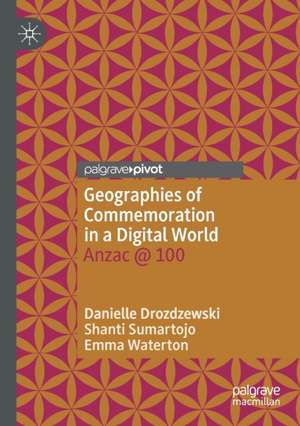Geographies of Commemoration in a Digital World: Anzac @ 100
Autor Danielle Drozdzewski, Shanti Sumartojo, Emma Watertonen Limba Engleză Paperback – 22 aug 2022
| Toate formatele și edițiile | Preț | Express |
|---|---|---|
| Paperback (1) | 446.47 lei 6-8 săpt. | |
| Springer Nature Singapore – 22 aug 2022 | 446.47 lei 6-8 săpt. | |
| Hardback (1) | 452.62 lei 6-8 săpt. | |
| Springer Nature Singapore – 21 aug 2021 | 452.62 lei 6-8 săpt. |
Preț: 446.47 lei
Nou
Puncte Express: 670
Preț estimativ în valută:
85.43€ • 89.38$ • 70.97£
85.43€ • 89.38$ • 70.97£
Carte tipărită la comandă
Livrare economică 03-17 aprilie
Preluare comenzi: 021 569.72.76
Specificații
ISBN-13: 9789811640216
ISBN-10: 9811640211
Pagini: 152
Ilustrații: XIII, 152 p. 15 illus.
Dimensiuni: 148 x 210 mm
Greutate: 0.23 kg
Ediția:1st ed. 2021
Editura: Springer Nature Singapore
Colecția Palgrave Pivot
Locul publicării:Singapore, Singapore
ISBN-10: 9811640211
Pagini: 152
Ilustrații: XIII, 152 p. 15 illus.
Dimensiuni: 148 x 210 mm
Greutate: 0.23 kg
Ediția:1st ed. 2021
Editura: Springer Nature Singapore
Colecția Palgrave Pivot
Locul publicării:Singapore, Singapore
Cuprins
Chapter 1: Geographies of commemoration in a digital world.- Chapter 2: Epistemology of memory.- Chapter 3: Encounters with Anzac in a digital world: tropes and symbols, spectacle and staging.- Chapter 4: Digital presence and absence.- Chapter 5: Digital feelings.- Chapter 6: Using geography to think-through and towards new commemorative frontiers.
Notă biografică
Danielle Drozdzewski is Associate Professor of Human Geography at Stockholm University.
Shanti Sumartojo is Associate Professor of Design Research at Monash University and a member of the Emerging Technologies Research Lab.
Emma Waterton is Professor in the Geographies of Heritage at Western Sydney University.
Textul de pe ultima copertă
‘How does Anzac feel? Why does it continue to have such a hold on the Australian imagination? And how are digital technologies affecting the ways that we experience Anzac? These are the questions at the heart of this compelling and innovative new book by Danielle Drozdzewski, Shanti Sumartojo and Emma Waterton. It argues convincingly for a new geography of commemoration that recognises the complex ways that digital commemoration interacts with traditional forms. The authors’ insights have important applications in enabling scholars across disciplines to better understand the affective appeal of state-sponsored mythologies.’
—Dr Carolyn Holbrook, DECRA Senior Research Fellow, Deakin University, Australia
‘This accessible book reveals the deep, emotional and mnemonic digital and cultural work of the public during national commemorations. This is cultural work through the co-produced methodology that offers the reader new ways of undertaking participatory research in memory studies. Story becomes action (real-time and remembered) as the authors reveal the phatic experience of Australia’s Anzac memories online as a constellation of digital places and feelings and fresh empirical evidence of non-conformity. The originality of this book lies in its collaborative methods across different but inter-related approaches to researching remembrance in the 21st century.’
—Joanne Garde-Hansen, Professor of Culture, Media & Communication, University of Warwick, UK
Caracteristici
Provides a significant, accessible and interdisciplinary resource for academics and students interested in the geographies of memory, nostalgia, and identity, and will be of particular interest to those working in the disciplines of human geography, heritage studies, history, anthropology, historical and conflict archaeology, memory studies and oral historians Engages with an international audience, providing case studies from the Australian context that intersect with current and internationally-relevant themes and perspectives, particularly those that emerged from the First World War centenary Comprises a valuable resource for students and academics attempting to develop a more critical practice when identifying and debating a range of issues regarding commemoration, ‘the past’, memory, identity and theories of emotion
